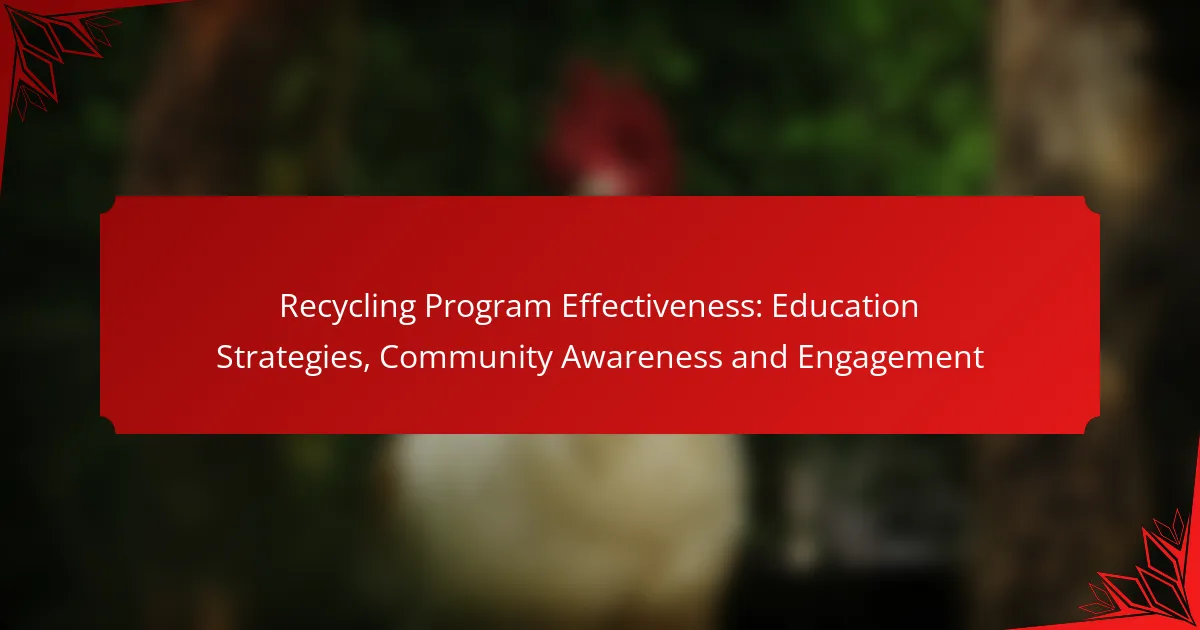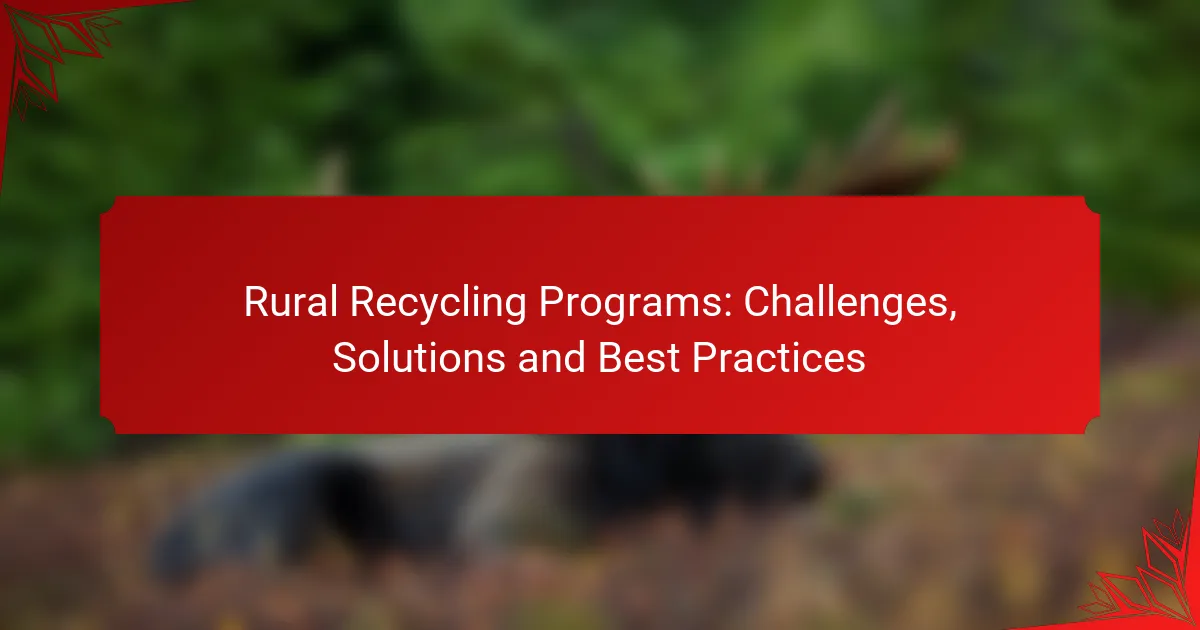Effective recycling programs in urban areas rely on community involvement, educational resources, and partnerships with local businesses to enhance participation and improve waste management. By implementing interactive workshops and seminars, these programs can raise awareness and provide practical knowledge about recycling practices. Engaging the community fosters a sense of responsibility, encouraging residents to take ownership of their recycling efforts and contribute to a sustainable future.
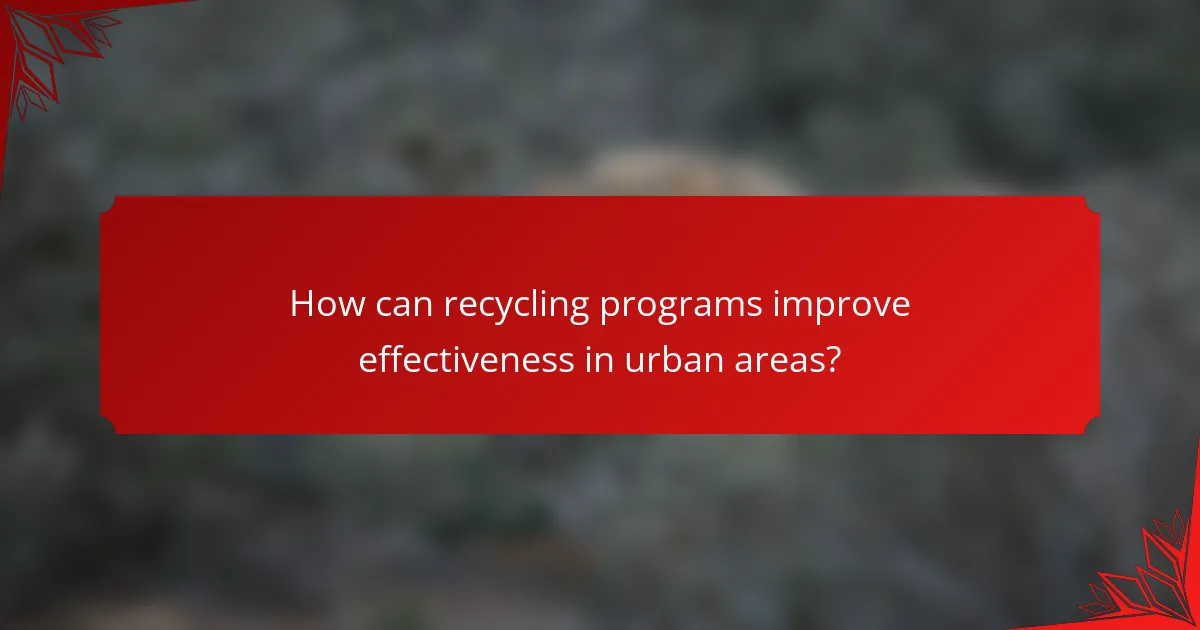
How can recycling programs improve effectiveness in urban areas?
Recycling programs can enhance their effectiveness in urban areas by fostering community involvement, providing educational resources, and collaborating with local businesses. These strategies help create a culture of recycling, leading to higher participation rates and better waste management outcomes.
Increased community participation
Engaging the community is crucial for the success of recycling programs. Initiatives such as neighborhood clean-up events, recycling drives, and informational workshops can motivate residents to participate actively. Offering incentives, like discounts on utility bills or local business vouchers, can further boost involvement.
To maintain momentum, cities should regularly communicate the benefits of recycling, such as reducing landfill waste and conserving resources. Utilizing social media platforms and local newsletters can effectively keep the community informed and engaged.
Enhanced educational outreach
Education plays a vital role in improving recycling effectiveness. Programs should focus on teaching residents about proper recycling practices, including what materials are recyclable and how to prepare them for collection. Workshops in schools and community centers can help spread this knowledge.
Visual aids, such as posters and infographics, can reinforce learning. Providing clear, concise information about the recycling process and its environmental benefits can help residents understand the importance of their participation.
Partnerships with local businesses
Collaborating with local businesses can significantly enhance recycling efforts. Businesses can serve as collection points for recyclable materials or sponsor community recycling events. This partnership not only increases recycling rates but also demonstrates corporate social responsibility.
Additionally, businesses can offer discounts or promotions to customers who participate in recycling programs, creating a win-win situation. Establishing a network of local partners can amplify outreach and create a more sustainable community approach to waste management.
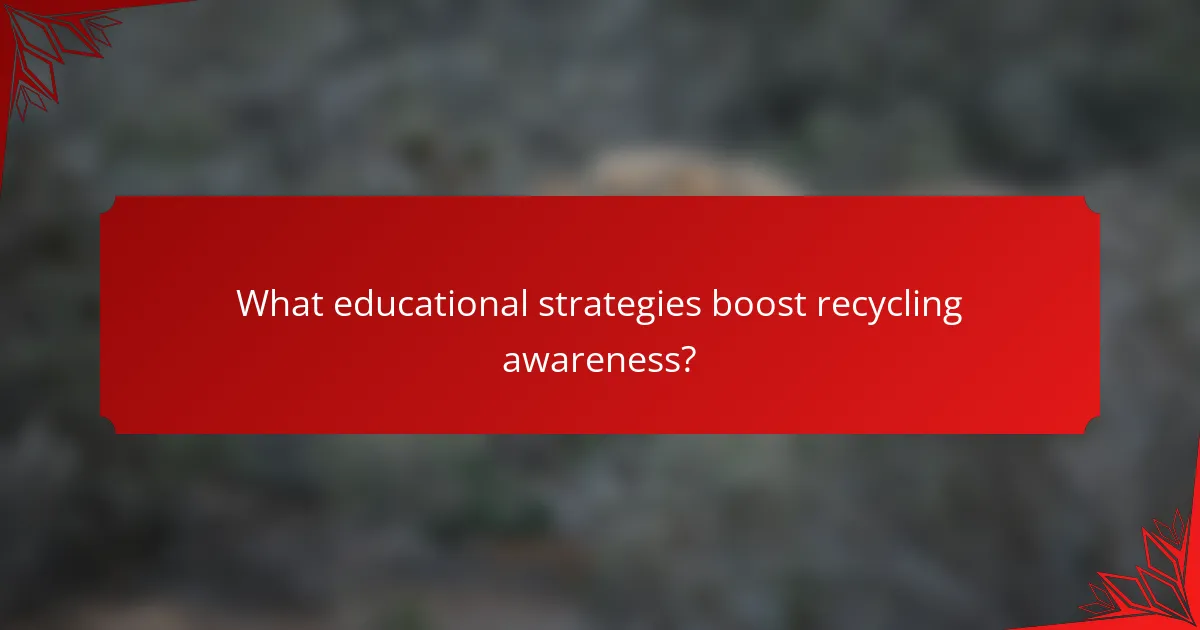
What educational strategies boost recycling awareness?
Effective educational strategies that enhance recycling awareness include interactive workshops, community seminars, and online resources. These methods engage individuals and provide practical knowledge about recycling practices, fostering a culture of sustainability.
Workshops in schools
Workshops in schools serve as a hands-on approach to teaching students about recycling. These sessions can include activities like sorting recyclable materials and creating art from waste, making the learning experience engaging and memorable.
Incorporating local recycling guidelines and practices into these workshops ensures that students understand the specific regulations that apply in their community. This localized approach can significantly increase the likelihood of students adopting recycling habits at home.
Community seminars
Community seminars provide a platform for residents to learn about recycling initiatives and best practices. These events can feature guest speakers from local waste management authorities who explain the importance of recycling and how it impacts the environment.
Offering incentives, such as discounts on utility bills or local business vouchers for attendees, can increase participation. Additionally, providing printed materials summarizing key points can help reinforce the information shared during the seminar.
Online educational resources
Online educational resources, such as websites and social media campaigns, are crucial for reaching a broader audience. These platforms can offer videos, infographics, and interactive quizzes that make learning about recycling accessible and engaging.
Creating a dedicated section on local government websites that outlines recycling guidelines, tips, and FAQs can serve as a valuable reference for residents. Regular updates and reminders about recycling events or changes in regulations can keep the community informed and motivated to participate.
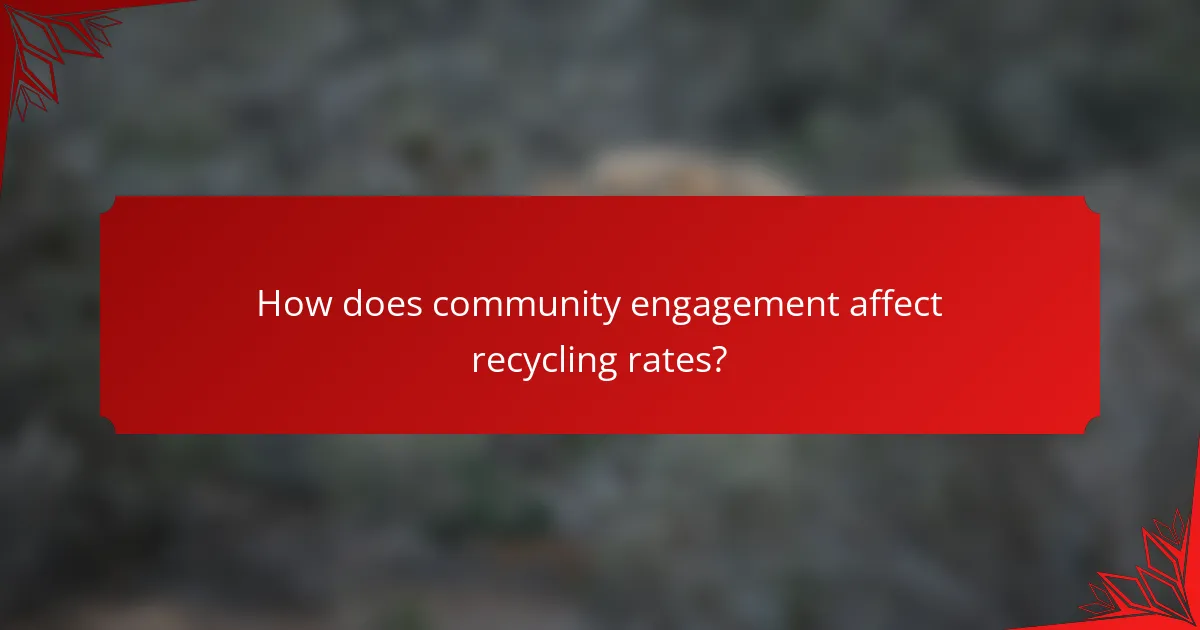
How does community engagement affect recycling rates?
Community engagement significantly boosts recycling rates by fostering a sense of responsibility and ownership among residents. When individuals feel connected to their community’s recycling efforts, they are more likely to participate actively and consistently.
Higher recycling participation
Engaging the community through educational programs and local events can lead to higher recycling participation. For example, neighborhood clean-up days or recycling drives can motivate residents to recycle more frequently. Studies show that communities with active engagement initiatives often see participation rates increase by 20-30% compared to those without such programs.
To maximize participation, consider implementing friendly competitions between neighborhoods or offering incentives like discounts at local businesses for those who recycle regularly.
Improved public perception
Community engagement can enhance public perception of recycling programs. When residents are informed about the benefits of recycling and see their neighbors participating, they are more likely to view recycling positively. This shift in perception can lead to a culture of sustainability within the community.
Utilizing social media platforms to share success stories and recycling tips can further improve public perception. Highlighting local champions or showcasing the environmental impact of collective efforts can inspire others to join in.
Increased volunteer initiatives
Active community engagement often results in increased volunteer initiatives focused on recycling and waste reduction. Volunteers can help organize events, educate others, and even assist with the logistics of recycling programs. This grassroots involvement not only enhances program effectiveness but also builds community bonds.
To encourage volunteerism, provide clear roles and responsibilities, and recognize volunteers publicly. Simple actions, like hosting appreciation events or featuring volunteers in local newsletters, can significantly boost participation and commitment.
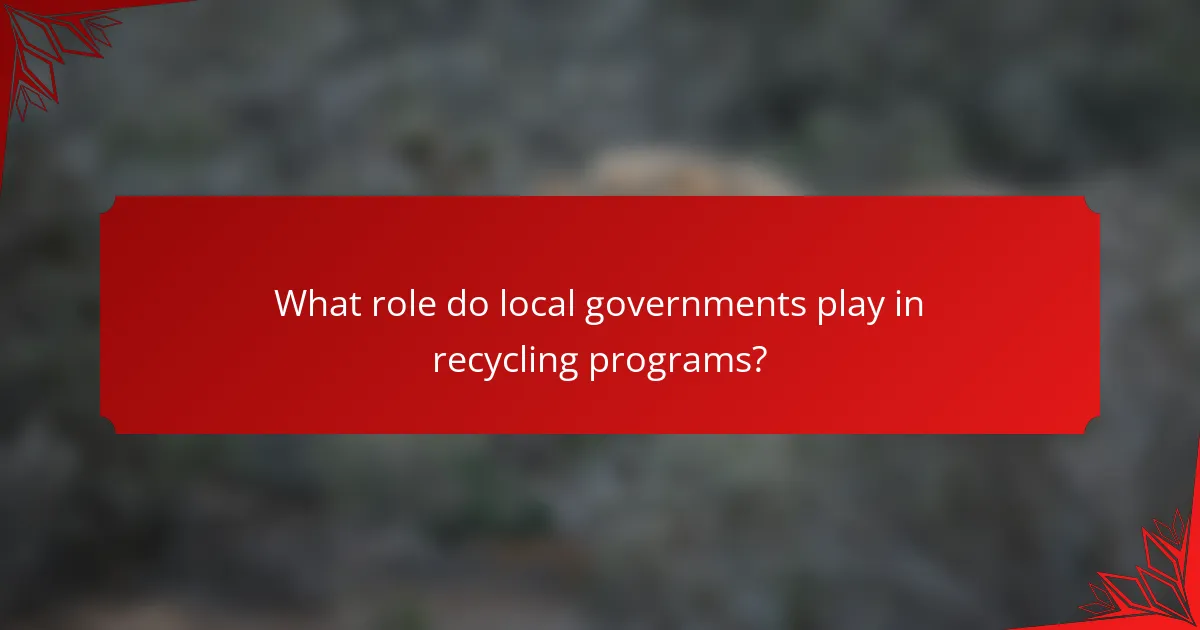
What role do local governments play in recycling programs?
Local governments are essential in establishing and managing recycling programs, ensuring compliance with regulations, and promoting sustainable waste management practices. They create policies, allocate funding, and engage the community to enhance recycling effectiveness.
Policy development
Local governments develop policies that set the framework for recycling initiatives. These policies often include guidelines on what materials can be recycled, collection schedules, and penalties for non-compliance. Effective policy development involves stakeholder consultation to address community needs and environmental goals.
For example, a city might implement a policy mandating that all residents separate recyclables from general waste, with clear definitions of accepted materials. This clarity helps reduce contamination rates in recycling streams.
Funding and resources
Funding is critical for the success of recycling programs. Local governments typically allocate budgets for collection services, processing facilities, and educational materials. They may also seek grants or partnerships with private organizations to enhance available resources.
In many cases, governments can leverage state or federal funding to support recycling initiatives. For instance, a municipality might receive a grant to improve its recycling infrastructure, leading to increased participation and higher recycling rates.
Public awareness campaigns
Public awareness campaigns are vital for engaging the community in recycling efforts. Local governments often run educational programs to inform residents about the benefits of recycling and proper practices. These campaigns can include workshops, social media outreach, and informational flyers.
Effective campaigns often highlight the environmental impact of recycling, such as reducing landfill waste and conserving natural resources. For example, a campaign might show how recycling a ton of paper saves several trees, encouraging residents to participate actively in recycling programs.
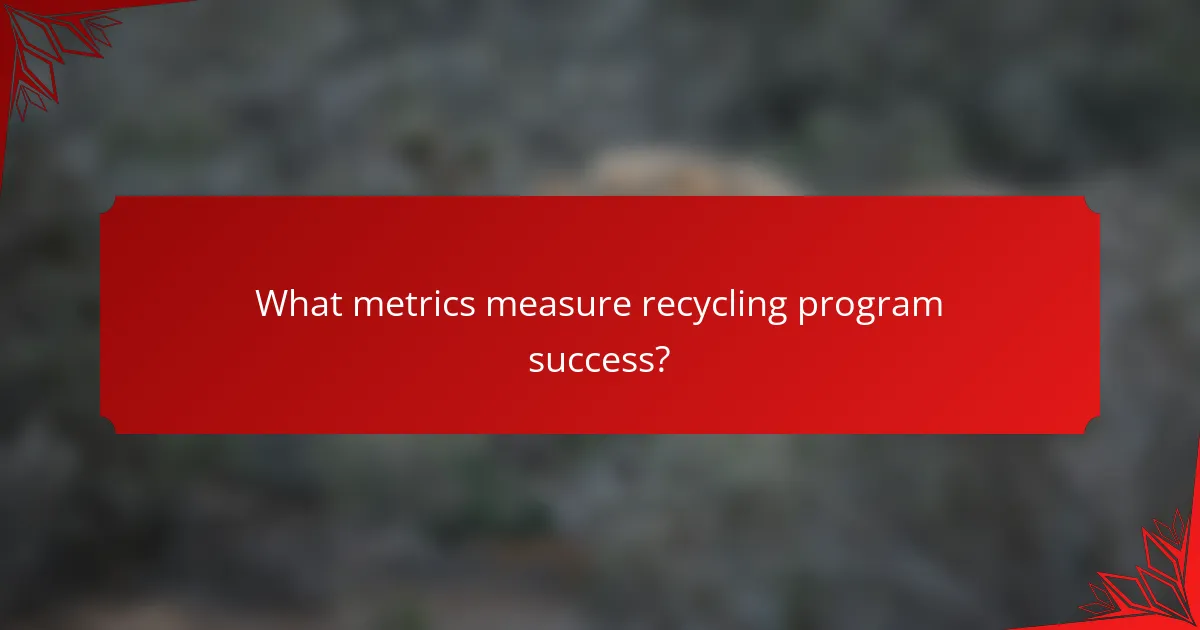
What metrics measure recycling program success?
Recycling program success is typically measured using several key metrics that reflect both participation and effectiveness. These metrics help communities assess how well they are diverting waste from landfills and engaging residents in sustainable practices.
Recycling rate percentages
Recycling rate percentages indicate the proportion of waste that is successfully recycled compared to the total waste generated. A successful program often aims for recycling rates in the range of 30% to 50%, depending on local infrastructure and community engagement. Tracking these percentages over time can reveal trends and areas for improvement.
To calculate the recycling rate, divide the total weight of recycled materials by the total weight of waste generated, then multiply by 100. For example, if a community generates 1,000 tons of waste and recycles 300 tons, the recycling rate would be 30%.
Community feedback surveys
Community feedback surveys are essential for gauging public awareness and satisfaction with recycling initiatives. These surveys can provide insights into residents’ understanding of recycling guidelines, barriers to participation, and suggestions for improvement. Regularly conducting surveys can help identify knowledge gaps and areas where educational efforts should be focused.
Surveys can be distributed online or through community events, and should include questions about recycling habits, perceived challenges, and overall satisfaction with the program. Analyzing the results can guide adjustments to outreach strategies and educational materials.
Cost-effectiveness analysis
Cost-effectiveness analysis evaluates the financial viability of recycling programs by comparing the costs of collection, processing, and education against the savings from reduced landfill use and potential revenue from recycled materials. A well-structured analysis can help communities allocate resources more efficiently and justify investments in recycling infrastructure.
When conducting a cost-effectiveness analysis, consider both direct costs, such as collection and processing fees, and indirect costs, like environmental impacts and public health benefits. Communities should aim for programs that not only reduce waste but also provide economic benefits, ideally achieving a positive return on investment over time.
